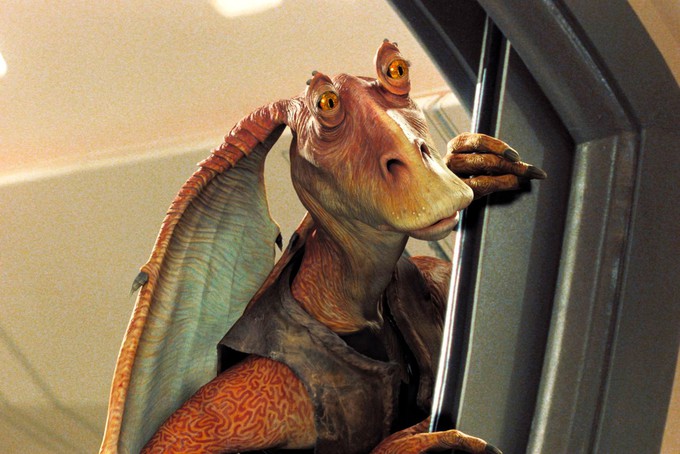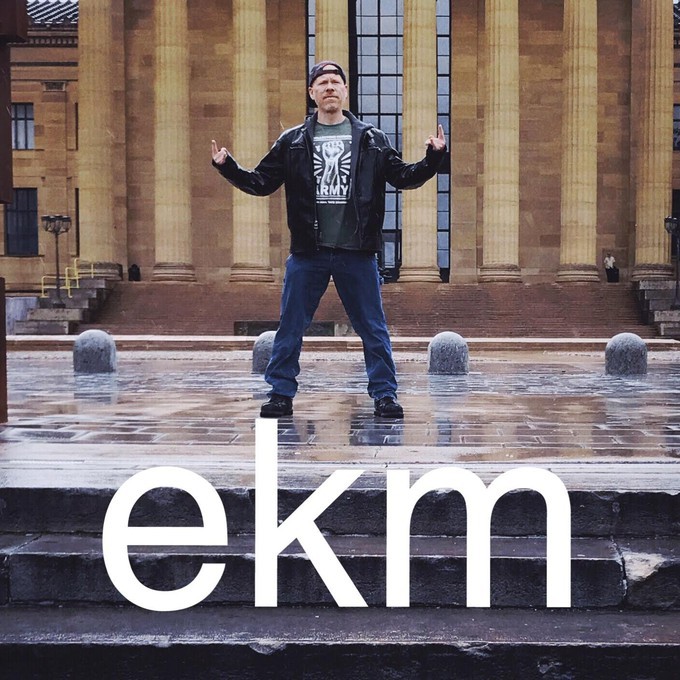ekm’s 31 DAYS OF THE FOURTH: EPISODE 12 – THE PASSION OF THE BINKS

In my discussion of THE PHANTOM MENACE, I zeroed in on my biggest issues with the film: the telescoping of events and how this introduced narrative incompatibilities into the STAR WARS timeline, and the story’s portrayal of Jedi Knights and The Force. Removed from the hype surrounding the film’s opening, it’s far easier to focus now on how issues of this sort negatively impacted EPISODE I and the sequels that followed, and retroactively altered the Original Trilogy; but in the summer of 1999, these Big Picture concerns went unnoticed by all but the more academic-minded of fans, because everyone was talking about one aspect of THE PHANTOM MENACE and one aspect only: Jar Jar Binks.
For those following the film’s development within the pages of STAR WARS INSIDER, or maybe one of those slow-loading websites on the newfangled Interwebnetdotcoms, Jar Jar was probably the single most hyped feature of the upcoming trilogy. Not even Darth Maul, the breakout character in MENACE, received the sort of lip service Lucasfilm was dedicating to the heroic Gungan. After all, Maul was a stunt guy in red and black makeup, whereas Jar Jar Binks represented an unprecedented leap forward in special effects, and how this technology could be used to create that which was previously impossible.
If we examine the Prequel Trilogy’s inception, it doesn’t take J.P. Fletcher to see that it was all JURASSIC PARK’s fault. Lucas has all but admitted as much. Spielberg and Lucas have shared not only a deep friendship since meeting in the early 70s, but a friendly rivalry as well. When one topped the other’s record-breaking box office total, the “loser” historically placed a congratulatory ad in VARIETY wishing their friend well (while simultaneously scheming to top this victory with their next film). I think it’s actually a pretty healthy sort of contest: finding new ways to raise the bar typically produces better and more original art, while maintaining friendships and collaborating on one another’s work. Lucas (George and Marcia both), Spielberg, Coppola, Milius, DePalma, Scorcese, along with artisans like Schrader, Murch, Williams, Burtt, Hirsch, Chew, Willard, Hyuck -- these guys and gals all made contributions that were invaluable to the films produced by the respective individual. Each director’s work contained familiar fingerprints that elevated the final product. Independent filmmaker friends, take note.
So Industrial Light & Magic -- the special effects company developed and owned by George Lucas -- broke new digital ground for Spielberg’s JURASSIC PARK in 1993, creating photorealistic dinosaurs unlike anything the world had seen up to that point. It was like a light switch went on in The Creator’s head: he would now make the fabled STAR WARS Prequels, and they’d be the most daring and visionary cinematic films unleashed in this galaxy, or in any other galaxy far, far away. With computers, he was no longer restrained by the limitations of location shooting, as he’d soon discover on THE YOUNG INDIANA JONES CHRONICLES, and could even go so far as to correct an actor’s performance by digitally swapping a mouth from one take and pasting it onto another. He didn’t have to build sets. He wouldn’t be forced to compromise a concept artist’s design based on what was possible with physical objects in a three dimensional space. An underwater city? No problem. A drag race that put all drag races to shame, and made even the speeder bikes in JEDI look slow and primitive? Absolutely. No problem. Literally anything was possible.
And Jar Jar Binks was the crown jewel in his design. After all, if dinosaurs could be brought to digital life, then why not a living, breathing humanoid who delivered dialogue and an emotive performance? An animated character who shared the screen with flesh and blood characters, with both co-existing and reacting and responding to one another? Sure, this had been accomplished in short bursts by Disney decades prior using hand-drawn animation techniques, and more recently with WHO FRAMED ROGER RABBIT?; but this would be the next logical step. Jar Jar would be to pixels what Yoda was to puppets: a completely believable artifice, and a stunning transformative moment in special effects history.
And he was. Jar Jar was, and still is, an amazing achievement. When I saw THE PHANTOM MEANCE on opening day, I wasn’t feeling the hate he inspired in so many others -- all I could do was stare in wonderment. What the character represented as he physically interacted with Liam Neeson and the rest of the cast was the realization that no concept was impossible. Someday, entire films could be animated this way! Just think what would happen once the same technology was applied to a serious dramatic performance, like, say, Gollum…? Or when live actors could be replaced by fully-animated, photorealistic duplicates for dangerous or impractical stunt sequences…?
So yeah, I admit it: I wasn’t a Jar Jar hater. My negative response to the film was due to its disregard for continuity and logic. I didn’t even care so much about THE PHANTOM MENACE as its own thing so much as how it affected, positively or negatively, STAR WARS, EMPIRE, and JEDI. Jar Jar was something else entirely, though, and I didn’t have an issue with him, mostly because I was 1) too preoccupied with the narrative issues, and 2) genuinely impressed by what ILM and Lucasfilm had created. Yeah, I knew he was obnoxious, but while the film was rolling (and before I found the disappointment too great to further rationalize), I was predicting that he was going to play the Sam Gamgee role: a simple, comic relief character who gradually gains nobility. That would be his arc. "Of course they're making him obnoxious now! That way, when he dies in EPISODE III during a heroic sacrifice to smuggle the twins away from Anakin and the Jedi Purge, there won't be a dry eye in the theatre!" I genuinely believed this.
The reality is that he was just a comic relief character, like C-3P0 had been. He was harmless, other than being too prominent; but the film was already broken on so many other levels, anyway, so why single out one character among many who didn’t work, either? Jar Jar was just one component, and significantly less detrimental than the obvious plot holes the story kept presenting.
It’s with that mindset taken into consideration that you’ll understand I was stunned when the backlash began.
At first it was on the message boards and in the online forums I frequented, like right here at AICN. Then it began to seep into mainstream news. People genuinely disliked this character; they, in fact, hated him. There were anti-Jar Jar websites featuring crude Photoshop depictions of his death in clever (and not-so-clever) ways that were both funny and alarming at the same time. Far more damaging was Spike Lee’s ranting to the press that Jar Jar Binks was a racist stereotype -- a twenty-first century Stepin’ Fetchit. It wasn’t hard to see the line of comparison: Jar Jar’s sloping walk, high-pitched voice, ‘Fraidy Cat nature and pidgin English, all evoked outdated caricatures of African-Americans as depicted in films of the 1930s and 40s…the same era that Lucas has cited repeatedly as the inspiration for STAR WARS. It didn’t help that the character was performed by Ahmed Best, who will forever be known as The Black Guy Who Wore Blackface.
From that point, the snowball effect began, and it wasn’t long before Watto the junk dealer was a Greedy Arab, and the Nemoidians were Asians (despite their incongruous pseudo-Transylvanian accents). Lucas himself was genuinely shocked: all he could repeat was that Jar Jar wasn’t intended to be Jamaican. The African-American community wasn’t trying to make that point, George.
The second time I saw the film (aka When I Tried To Force Myself To Like It And Was Depressed To Find My Mind Wandering During The Podrace), I eyeballed Jar Jar more closely. All of the criticisms had apparently gone over my head during that first viewing, and on the second go-round, I could see it. There it was, hiding in plain sight. When I returned the following week for my third (and final) screening, it stood out like a sore thumb from the moment the character first squeals in comic terror at the sight of the approaching Trade Federation vehicles. STAR WARS had managed to become both boring and offensive.
As stated, we’re two decades removed from the release of THE PHANTOM MENACE. Time has cooled tempers and cleared heads. This probably says less about the content of the film than it does the footnote this film has become in a much larger discussion. To this day, I’m still not sure whether I would have drawn the comparison had it not been inflated into a major news story; I’m also unsure whether or not that makes me insensitive. I simply took Jar Jar as a character wonderfully-realized despite the juvenile nature of his presentation. The only “black people” I noted were Captain Panaka and Mace Windu, because…well, they are. Were critics reading too much into this whole thing, or was I not reading enough? And now that I saw it, was it because I’d become predisposed to accepting a prescribed literal reading of the text rather than assessing (and possibly dismissing) a subjective one…?
Perhaps THE PHANTOM MENACE had the benefit and handicap of being too visible in 1999, and thus too easy to tear down. It was the most anticipated film of all time, which tends to bring out the vultures. Lucas himself was oblivious to how his creation would be perceived throughout the process of bringing it to life, as were the men and women in the hundreds who participated in his design. There’s a lot to be said about the subconscious manifesting itself in art -- I’ve had things pointed out in my own work that were clear extensions of my thoughts or emotions that I never noticed despite being immediately recognizable to others. Does this mean George Lucas is racist? You’ll have to ask his current wife.
One thing’s for certain: Jar Jar Binks was almost entirely eliminated from ATTACK OF THE CLONES and REVENGE OF THE SITH. This is emblematic of the clear shift that began with EPISODE II, with a frantic Lucas modifying his story to pacify a disgruntled fan base rather than telling it the way he chose. The next two films became pandering, hodgepodge affairs lacking the identity that gave THE PHANTOM MENACE its own unique voice; Lucas was now choosing to shoehorn as many characters and visual callbacks to THE EMPIRE STRIKES BACK as possible to regain loyalty that was once unconditional.
It’s worth noting, though, the not-so-subtle resentment that manifests as Lucas gave audiences the revelation that the Gungan everyone hated was directly responsible for creating the Empire. After that, the character never speaks again until he appears during a new epilogue for the revised RETURN OF THE JEDI, screaming WEESA FREE! This is now the very last line of dialogue spoken in the six-part STAR WARS saga, as produced by George Lucas. If that’s not a Fuck you, then I don’t know what is.

